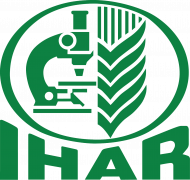Rhizoctonia solani is an emerging necrotic and aggressive pathogenic basidiomycete able to attack a wide range of crops, including potato; therefore, the development of eco-friendly compounds could be good substitution for the chemical pesticides. This study evaluates the antifungal activity of essential oils (EOs) extracted from leaves of lavender (Lavandula dentata), lemongrass (Cymbopogon citratus), and sage (Salvia officinalis) against Rhizoctonia solani. The chemical composition of EOs was determined by GC-FID (gas chromatography—flame ionisation detection) and GC–MS (gas chromatography-mass spectrometry). Geranial (42.78%) and neral (32.82%) were the main components of lemongrass oil; lavender oil was rich in 1,8-cineole (40.26%) and camphor (23.82%), while the major components of sage oil were camphor (25.59%), α-thujone (22.21%), and 1,8-cineol (16.97%). The in vitro growth of R. solani was completely inhibited by lemongrass essential oil at 3000 and 4000 ppm; however, sage essential oil represented less inhibitory activity even at the highest concentration (71% at 4000 ppm). Furthermore, scanning electron microscopy of mycelium of R. solani subjected to EOs treatment, especially with lemongrass and lavender, exhibited obviously deleterious morphological and ultrastructural alterations when compared to the control. In vivo study showed that the application of lavender oil significantly reduced disease severity on potato tubers, and it completely inhibited the mycelium development. Therefore, EOs from lavender and lemongrass hold promise as natural antifungal alternatives for sustainable crop protection to protect potato tubers against R. solani.
Full publication URL















